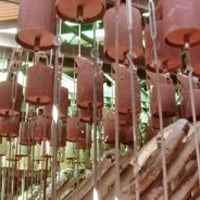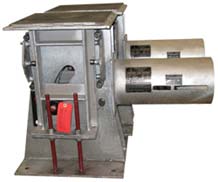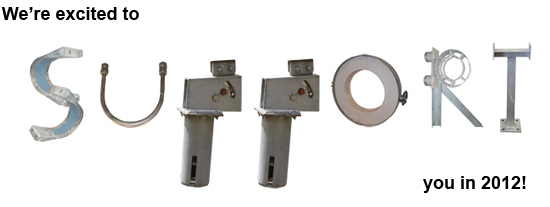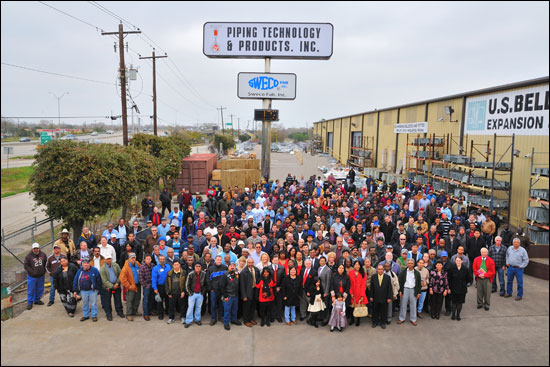Subject: Pipe Supports and Expansion Joints for Furnace Applications
This Webinar is over, visit www.pipingtech.com/webinar to view the recording.


Piping Technology & Products

Tags: variable furnace springs, Expansion Joints, constant furnace springs, furnace bags
Fronek Anchor/Darling Enterprises, a division of PT&P designed and fabricated hydraulic snubbers for a geothermal facility in California. The Fig. 510 AD snubbers ranged in size from 34-3/4" to 37-5/8" piston-to-piston and were designed for a 50,000 lb. maximum load, 5" cylinder size and a 6" stroke. The Fig. 511 AD snubbers ranged in size from 56-15/16" to 59-5/16" P-P and were designed for a 20,000 lb. maximum load, 2-1/2" cylinder size and a 6" stroke. Hydraulic snubbers are designed to protect the piping system when a sudden, heavy load is applied (such as an earthquake of high intensity), which can cause serious vibrations leading to complete destruction. A custom three-bolt pipe clamp fabricated from carbon steel was designed to fit in a limited space. A cycle test throughout the full stroke from zero to fully extended was performed prior to shipment.
Tags: Snubbers, Hydraulic Snubbers
Follow these 7 steps below to maintain and extend the life span of your hydraulic snubber.
1. Observe the fluid level to make sure there is sufficient fluid for the snubber to operate
2. Check for leaks - If the fluid level is decreasing, determine the cause and effect remedial action.
3. Check the condition of the load pins and spherical ball bushings. Apply a high pressure grease for long-term benefits.
4. Check the condition of the exposed portion of the piston rod. Check for scoring, paint or other physical damage.
5. Check the condition of the piston rod wiper. Verify that it's in position and working effectively.
6. Check for evidence of abuse like welding arc strikes, bent or dented parts, scratched paint, etc.
7. Finally, check the overall physical appearance. This encompasses all of the above.
 CPS Systems are defined in Chapter 1 Par 100.2, as systems on which condition assessments are to be conducted. This includes the following systems as a minimum. NPS 4 and larger main steam, hot reheat steam, cold reheat steam, and boiler feedwater piping. NPS 4 and larger systems that operate above 750°E (400°C or above 1,025 psi (7,100 kPa) Other systems may be included as CPS by an Operating Company, based on their judgment. Appendix V of the code is titled 'Recommended Practice for Operation, Maintenance, and Modification of Power Piping Systems'. This addendum is non-mandatory; however many Power Industry operating companies' insurance carriers are now invoking Appendix V with increasing frequency, and this is affecting conditions of their agreements with the operating companies. Piping Technology and Products Inc. (PT&P) has for some time been performing surveys and assessments in accordance with part H of Par. 140, that requires hot and cold walk-down readings and assessment of pipe supports, operated within the creep regime of the pipe. These assessments are helpful in identifying, sagging lines, deformation of supports, and damage caused by upset conditions, and/or incidents, attributable to operational malfunctions, dynamic/thermal or hydraulic events. PT&P has been performing this service for many power generation companies. Preparation of documentation, retrieval and compilation of files for a CPS assessment, has just been completed for a major U.S power generation company. Ten large power plants were involved, and the original predominantly high-energy pipe support drawings, all engineered and designed by PT&P, were retrieved from PT&P archives dating back ten years. Please feel free to contact us at david.baker@pipingtech.com and we will be happy to answer any of your technical questions about our survey capabilities, as well as any other engineering or field services that your organization may need.
CPS Systems are defined in Chapter 1 Par 100.2, as systems on which condition assessments are to be conducted. This includes the following systems as a minimum. NPS 4 and larger main steam, hot reheat steam, cold reheat steam, and boiler feedwater piping. NPS 4 and larger systems that operate above 750°E (400°C or above 1,025 psi (7,100 kPa) Other systems may be included as CPS by an Operating Company, based on their judgment. Appendix V of the code is titled 'Recommended Practice for Operation, Maintenance, and Modification of Power Piping Systems'. This addendum is non-mandatory; however many Power Industry operating companies' insurance carriers are now invoking Appendix V with increasing frequency, and this is affecting conditions of their agreements with the operating companies. Piping Technology and Products Inc. (PT&P) has for some time been performing surveys and assessments in accordance with part H of Par. 140, that requires hot and cold walk-down readings and assessment of pipe supports, operated within the creep regime of the pipe. These assessments are helpful in identifying, sagging lines, deformation of supports, and damage caused by upset conditions, and/or incidents, attributable to operational malfunctions, dynamic/thermal or hydraulic events. PT&P has been performing this service for many power generation companies. Preparation of documentation, retrieval and compilation of files for a CPS assessment, has just been completed for a major U.S power generation company. Ten large power plants were involved, and the original predominantly high-energy pipe support drawings, all engineered and designed by PT&P, were retrieved from PT&P archives dating back ten years. Please feel free to contact us at david.baker@pipingtech.com and we will be happy to answer any of your technical questions about our survey capabilities, as well as any other engineering or field services that your organization may need.These high temperature pipe supports have a 25" outside diameter, and were custom designed for a granular activated carbon manufacturing plant in Hawaii. They are fabricated from A-36 carbon steel with 10" thick high density calcium silicate insulation. The hot shoes were designed for a 4" diameter pipe-line, temperatures up to 1,800°F and an operating load of 1,000 lb. Standard Q.C. and dimensional tests were performed prior to an expedited shipment.
Do you require hot shoes on an upcoming project? Get pricing today!
 This Webinar will focus on the different types of constant spring supports. Learn about the special features available, in addition to the design of a constant support. View how the different cam/coil configurations produce a unique response to an applied load. Discover the step by step process used to size a spring for your application. Learn about the different attachments, testing, and installation and maintenance procedures. View examples of failed supports provided by our Field Service Division and learn why they failed and how to prevent it. Gain knowledge of the valuable tips used when deciding to adjust or replace a constant spring support, as well as shutdown and isolation procedures.
This Webinar will focus on the different types of constant spring supports. Learn about the special features available, in addition to the design of a constant support. View how the different cam/coil configurations produce a unique response to an applied load. Discover the step by step process used to size a spring for your application. Learn about the different attachments, testing, and installation and maintenance procedures. View examples of failed supports provided by our Field Service Division and learn why they failed and how to prevent it. Gain knowledge of the valuable tips used when deciding to adjust or replace a constant spring support, as well as shutdown and isolation procedures.

Tags: Piping Technology News
Want to learn more about variable springs? Check out a recording of a past live webinar.
Tags: Variable Spring Assemblies, Pipe Supports, Engineered Spring Supports
This Glycol Makeup Tank is fabricated entirely from ASTM A240-304 stainless steel and is rated for 0 psig at 150°F. The tank has a 1,000 gallon capacity and measures 48" I.D. x 10'-8" seam-to-seam. The stand pictured behind is also fabricated from stainless steel and measures 11' high. The customer ordered six additional units and all the Makeup Tanks underwent leak testing prior to shipment.
Want to learn more about variable springs? Check out a recording of a past live webinar.

Tags: history, Piping Technology News, Piping Technology History
Mailing: P.O. Box 34506, Houston, TX 77234-4506 Location: 3701 Holmes Road, Houston, TX 77051
Our Subsidiaries: U.S. Bellows: Metallic & Fabric Expansion Joints, Bellows
Sweco Fab: ASME Vessels, Pig Launchers, Spectacle Blinds
Pipe Shields: Pre-Insulated Pipe Supports, Slides, Guides & Anchors
Fronek Anchor/Darling: Snubbers, Sway Struts & Sway Braces
Phone: (713) 731-0030 Toll-Free: (800) 787-5914 FAX: (713) 731-8640 info@pipingtech.com
© 2015 Piping Technology and Products, Inc. All Rights Reserved. Contact Us | Privacy Policy